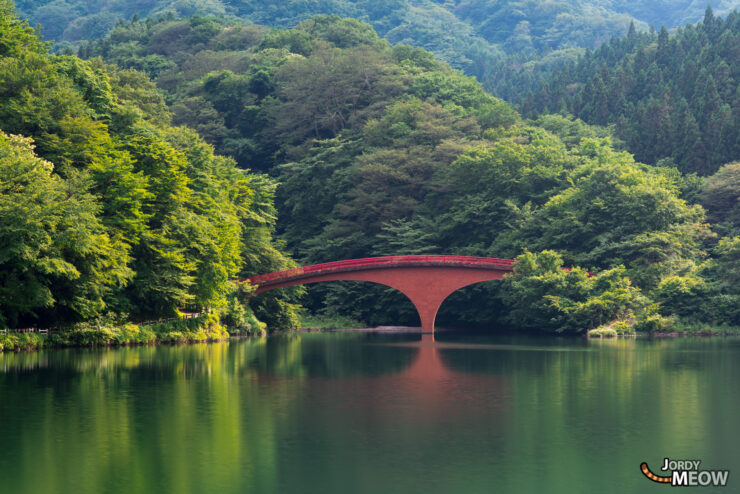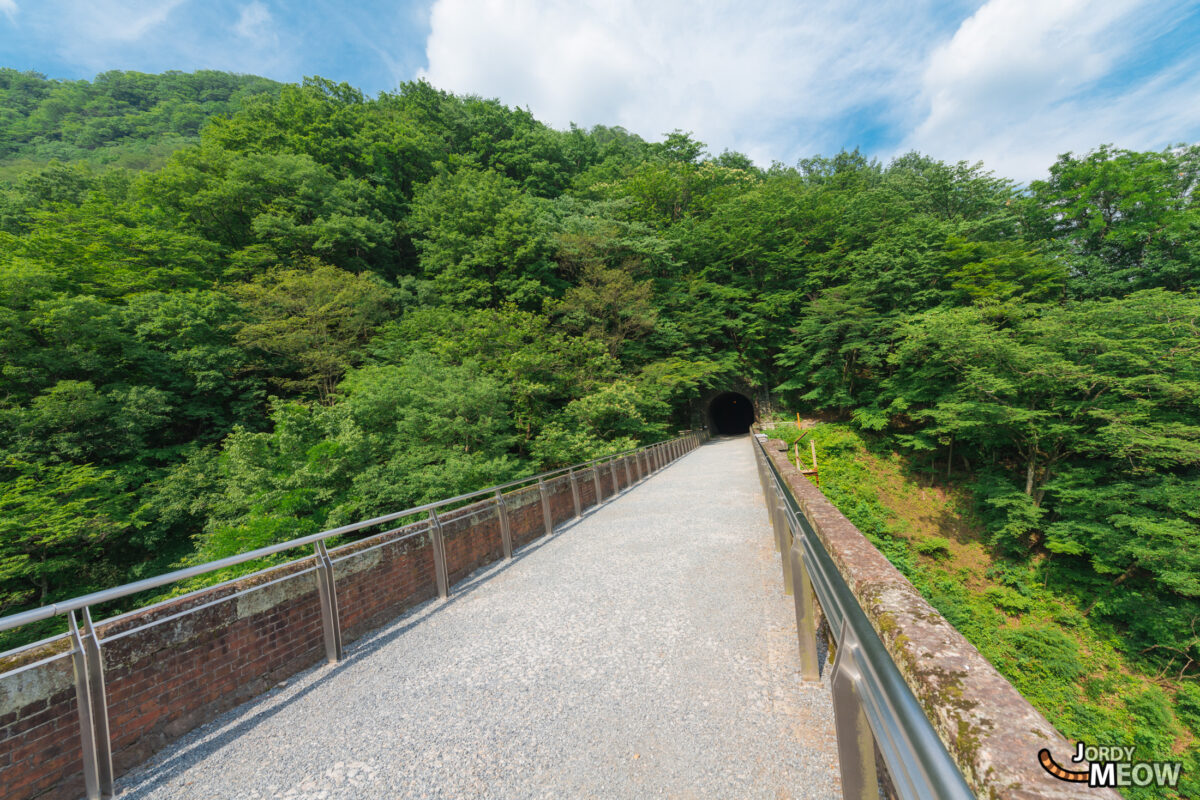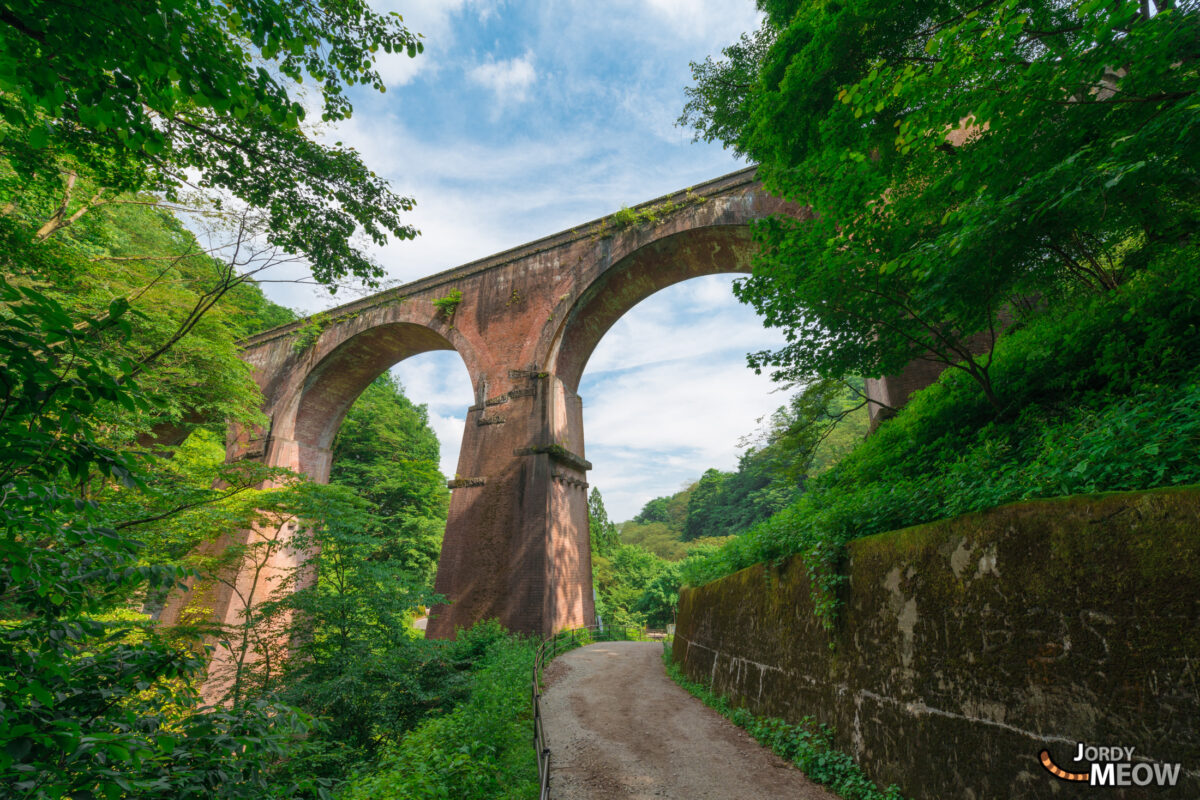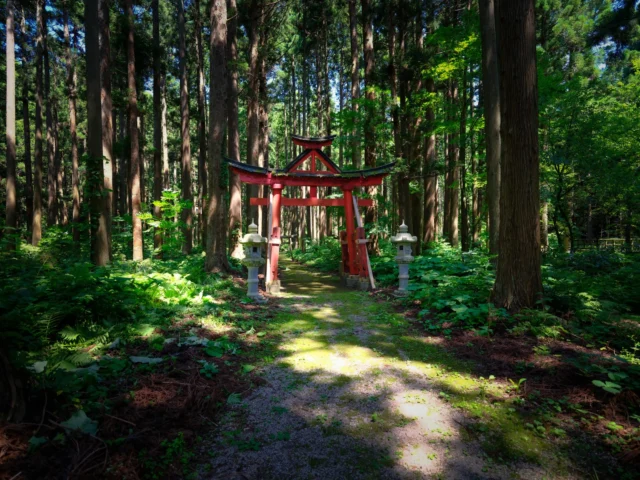The Usui Pass No.3 Bridge – generally known as Meganebashi (めがね橋) – is dazzling beautiful. With the nice photo below I do not think I need to explain too much in words. It is currently the biggest brick bridge in Japan, and not surprisingly they are trying to get it listed in the world heritage list (I am not sure whether Japan has the most world heritages listed but I am sure it is the most diligent country in applying :P).
As the world heritage candidate, what interesting history does this bridge have? Well well well, I was quite thrilled when I started digging into it, because it was built by 2 important figures in Japanese bridge history, Charles Assheton Whately Pownall (a British bloke hired by Japanese railway in the 1880s as the chief engineer) and Seiichi Furukawa (古川晴一), who also designed the Amarube.
Superb photo by R. Maruki.
Approaching the bridge from the road gives you the most impressive view. The weather is good, and the abandoned bridge looks the right object for our cameras. But why is it abandoned and how old is it?
At the year of 1891, the railway between Gunma Prefecture and Niigata Prefecture was built, and the only unfinished part was Usui pass. As we know Japanese are very serious about the set schedule, the bridge has to be built in light speed. And in 1893 it was finished. And if you look at the bridge now; a gigantic pile of more than 2,000,000 bricks put together in a rush… you probably would not want to ride the SL trains that was running on it.
We know our Japanese fellows, besides being serious about deadlines, they are also serious about qualities. Thus 1 year after the bridge’s opening, 1894, the bridge was criticized for not being strong enough. A great deal of strengthen work had to be done at the foot of the bridge to prevent it from collapsing. The bridge was used until 1963 when the electronic trains replaced the good old SL Usui.
I have always liked the Japanese bridges, and we have so many of them! There are these unusual brick ones, the common wooden bridges found in temples and the modern and impressive suspension bridges (driving on them non-stop in Shigoku was great fun!).
But my favorite remained with the unusual; those red iron bridges hidden in the deep mountain. We usually drive pass them on the way to abandoned places. The contrast of the red and the green surrounding created a perfect balance, peaceful and romantic. In my vision, some girl from the countryside is likely to appear on the bridge on an old fashioned bike…
Amazingly, we found a red iron bridge right next to the Usui pass as well! It was not my favorite hanging-between-big-mountains type, but the quiet lake gave it a unique touch. We took our time and played with 2 different lenses (the Nikon D800 with a Mamiya 35mm, and then with the Nikon 24-70 at 35mm). The results are below. Which one is your favorite? 😉
Another thing you will find in the countryside is the lonely but lovely bus stops. Like those where you can meet a totoro, and where you need to wait very patiently for the bus that rarely comes.
After all these nice and quiet places, we need to stir you a little bit! We will put a random haikyo, that is casually abandoned in the middle of this beautiful world. What do you think? Does the haikyo beat the bridge in the end? 😛
And for more awesome content about Japan, follow Jordy Meow on Instagram ! 🎵





















































The first red bridge shot in particular is a real stunner. Lovely!
Thanks for your comment Lee, I am glad you like that bridge. Filters and lakes can never go wrong together 🙂
It was actually an interesting picture to take: D800 + R72 filter + ND filter + a Mamiya fixed lens. I played for a while in front of that bridge, but it also looks really lovely isn’t it!? Its shape is somewhat… sexy.
I was too lead to this site when i saw the photo of the red bridge while surfing. Sorry I am a novice SLR user, may I know what is the diff between the R72 Filter and ND filter and what how do they affect the picture?
ND filter basically just blocks light like sunglasses, resulting in longer exposures with the DSLR and a “milky effect” on the water and a smoother sky. A R72 filter is very different and I didn’t use any in this article. A R72 only allows the infrared rays to pass through the lens. You’ll get mostly black and white or reddish pictures, and it requires a lot of post-processing to make them pop. Infrared photography is quite difficult imho.
Very interesting; I like bridges too, especially when they have been built for railways 🙂 I hadn’t seen any bridges made of bricks like this one before…
Your photos are really beautiful, I really like the first one of the red bridge and the bus stop is particularly lovely! It’s much more better than simple poles we usually have here!
There are impressive viaducts on the french network too. I really like this one, somewhere between Nîmes and Clermont-Ferrand, in Chamborigaud: IMG_3273.jpg (I took this picture from the train and I’m not as good as you two are with your cameras ^^). Morez, a small town in Jura mountains, is also famous for its viaducts, there even is a “viaduct day”! I took this picture a few years ago: ViaducsMorez.jpg. Try to imagine the route from the train ^^ (answer here: https://morez1900.net/CPA/Viaducs6.htm) If you like suspension bridges, look for “Pont Gisclard” on Google. It’s quite unusual to have such a piece of work for railroads, they usually are only used for roads. Then you should look for “Pont Séjourné”. Paul Séjourné is one of the best known masonry bridge architect in France. Ok now I suppose I should stop talking of stupid french viaducts because I don’t want to be too boring 🙂
Thanks to share your finds with us!
Thank you for your informative reply! I checked your website for the viaduct photo, the one in Chamborigaud is impressive, especially with the nice surroundings and cows. 😛 Thanks for the link of the answer, it sounds like a fun ride!
You seem to know a lot about bridges, are you a civil engineer? Or are you a train geek? 😛 We have a lot of them here in Japan, I am a half geek for trains, but I do not know much ><.
You’re welcome, thank you for this answer, your visit on my blog and your comment 🙂
Chamborigaud is a station on one of the most beautiful french line, La Ligne des Cévennes, which is well known for its landscapes. A part of the Allier gorges can only be seen from trains (except if you like walking). The blog post you’ve commented is mainly about a line which is connected to this one, going to Mende and called the “Translozérienne” 🙂 It’s a very beautiful line too, and because the train is very (very) slow, you’ve plenty of time to enjoy landscapes ^^ My pictures wasn’t very great and don’t honour this lovely region.
Indeed, traveling to Morez by train is a fun ride. I like to take the train to discover new cities, landscapes and places.
Actually I don’t know anything about bridges ^^ I just like some of them because they sometimes are “work of art”. And because railways aren’t as “flexible” as roads, they usually are necessary; so they almost are an integral part of “rail world”, which, as you’ve noticed, I really like.
I’m an engineer, but not a civil engineer 😛 I’m a (huge) train geek too, and I’m working in that field so… You were almost right! =D It’s unusual for a girl to be a train geek, even a “half geek” and I’m glad to read you like trains! You should ask those japanese “rail otaku” to learn you more things about them 🙂 It’s a really interesting field (and we’re not SO crazy after all :p).